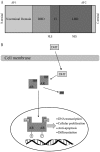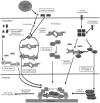Molecular and cellular mechanisms of castration resistant prostate cancer
- PMID: 29616091
- PMCID: PMC5876469
- DOI: 10.3892/ol.2018.8123
Molecular and cellular mechanisms of castration resistant prostate cancer
Abstract
With increases in the mortality rate and number of patients with prostate cancer (PCa), PCa, particularly the advanced and metastatic disease, has been the focus of a number of studies globally. Over the past seven decades, androgen deprivation therapy has been the primary therapeutic option for patients with advanced PCa; however, the majority of patients developed a poor prognosis stage of castration resistant prostate cancer (CRPC), which eventually led to mortality. Due to CRPC being incurable, laboratory investigations and clinical studies focusing on CRPC have been conducted worldwide. Clarification of the molecular pathways that may lead to CRPC is important for discovering novel therapeutic strategies to delay or reverse the progression of disease. A sustained androgen receptor (AR) signal is still regarded as the main cause of CRPC. Increasing number of studies have proposed different potential mechanisms that cause CRPC, and this has led to the development of novel agents targeting the AR-dependent pathway or AR-independent signaling. In the present review, the major underlying mechanisms causing CRPC, including several major categories of AR-dependent mechanisms, AR bypass signaling, AR-independent mechanisms and other important hypotheses (including the functions of autophagy, PCa stem cell and microRNAs in CRPC progression), are summarized with retrospective pre-clinical or clinical trials to guide future research and therapy.
Keywords: androgen receptor splice variants; autophagy; castration resistant prostate cancer; mechanism; microRNAs; prostate stem cells.
Figures




Similar articles
-
Androgen receptors in hormone-dependent and castration-resistant prostate cancer.Pharmacol Ther. 2013 Dec;140(3):223-38. doi: 10.1016/j.pharmthera.2013.07.003. Epub 2013 Jul 13. Pharmacol Ther. 2013. PMID: 23859952 Review.
-
A novel AR translational regulator lncRNA LBCS inhibits castration resistance of prostate cancer.Mol Cancer. 2019 Jun 20;18(1):109. doi: 10.1186/s12943-019-1037-8. Mol Cancer. 2019. PMID: 31221168 Free PMC article.
-
Transcript Levels of Androgen Receptor Variant 7 and Ubiquitin-Conjugating Enzyme 2C in Hormone Sensitive Prostate Cancer and Castration-Resistant Prostate Cancer.Prostate. 2017 Jan;77(1):60-71. doi: 10.1002/pros.23248. Epub 2016 Aug 22. Prostate. 2017. PMID: 27550197
-
Understanding Mechanisms of Resistance in Metastatic Castration-resistant Prostate Cancer: The Role of the Androgen Receptor.Eur Urol Focus. 2016 Dec;2(5):499-505. doi: 10.1016/j.euf.2016.11.013. Epub 2016 Dec 9. Eur Urol Focus. 2016. PMID: 28723515 Review.
-
Role of the Androgen-Androgen Receptor Axis in the Treatment Resistance of Advanced Prostate Cancer: From Androgen-Dependent to Castration Resistant and Further.J UOEH. 2016 Jun 1;38(2):129-38. doi: 10.7888/juoeh.38.129. J UOEH. 2016. PMID: 27302726 Review.
Cited by
-
Azolato-Bridged Dinuclear Platinum(II) Complexes Exhibit Androgen Receptor-Mediated Anti-Prostate Cancer Activity.Inorg Chem. 2024 Nov 4;63(44):20951-20963. doi: 10.1021/acs.inorgchem.4c01093. Epub 2024 Sep 11. Inorg Chem. 2024. PMID: 39258898 Free PMC article.
-
A review of tanshinone compounds in prostate cancer treatment.Transl Androl Urol. 2024 Jul 31;13(7):1278-1287. doi: 10.21037/tau-24-49. Epub 2024 Jul 11. Transl Androl Urol. 2024. PMID: 39100845 Free PMC article. Review.
-
Targeting a STING agonist to perivascular macrophages in prostate tumors delays resistance to androgen deprivation therapy.J Immunother Cancer. 2024 Jul 25;12(7):e009368. doi: 10.1136/jitc-2024-009368. J Immunother Cancer. 2024. PMID: 39060021 Free PMC article.
-
Efficacy of Enzalutamide Rechallenge for Metastatic Castration-Resistant Prostate Cancer.Asian Pac J Cancer Prev. 2024 Jun 1;25(6):1863-1867. doi: 10.31557/APJCP.2024.25.6.1863. Asian Pac J Cancer Prev. 2024. PMID: 38918645 Free PMC article.
-
Computational Modeling to Identify Drugs Targeting Metastatic Castration-Resistant Prostate Cancer Characterized by Heightened Glycolysis.Pharmaceuticals (Basel). 2024 Apr 29;17(5):569. doi: 10.3390/ph17050569. Pharmaceuticals (Basel). 2024. PMID: 38794139 Free PMC article.
References
-
- Society AC. Cancer facts & figures 2016. Atlanta: American Cancer Society; 2016.
-
- Thomas C, Bögemann M, König F, Machtens S, Schostak M, Steuber T, Heidenreich A. Advanced prostate cancer consensus conference (APCCC) 2015 in St. Gallen. Critical review of the recommendations on diagnosis and therapy of metastatic prostate cancer by a German expert panel. Urologe A. 2016;55:772–782. (In German) - PubMed
Publication types
LinkOut - more resources
Full Text Sources
Other Literature Sources
Research Materials
Miscellaneous
